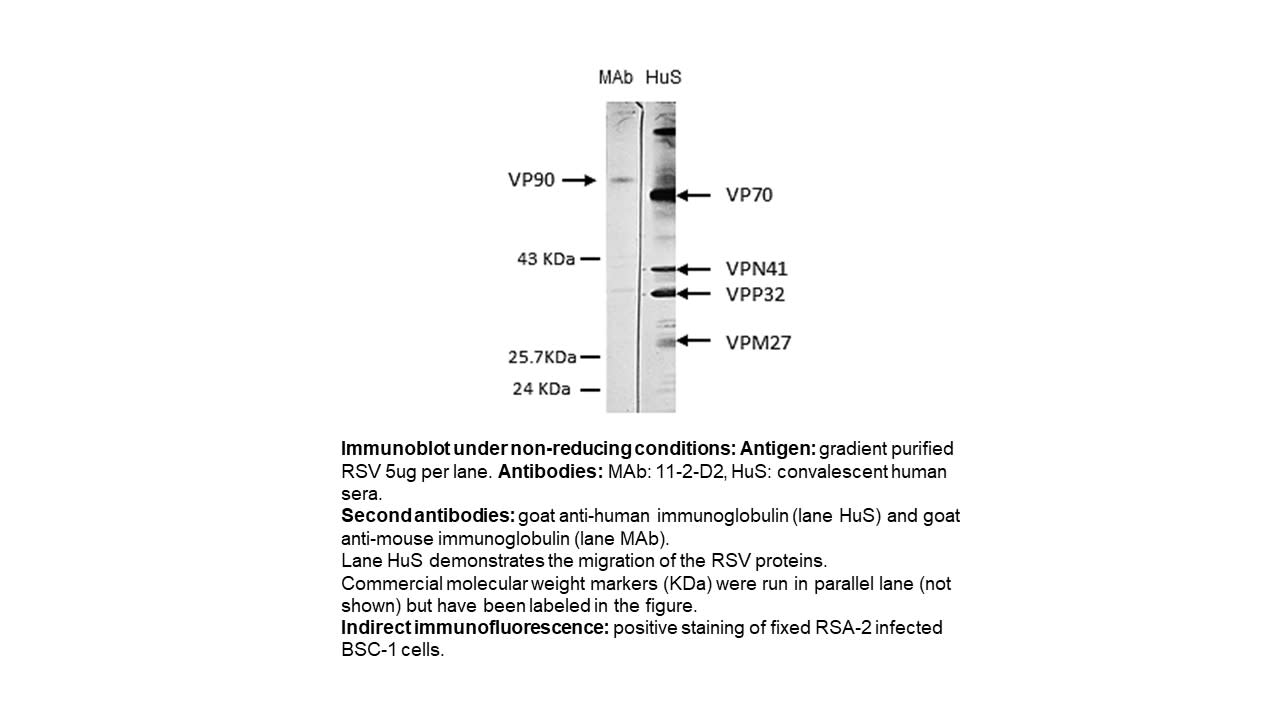Cat. #151859
Anti-RSV G Glycoprotein [11-2-D2]
Cat. #: 151859
Unit size: 100 ug
Availability: 3-5 days
Target: Human Respiratory Syncytial (RS) virus G glycoprotein
Class: Monoclonal
Application: ELISA ; IF ; Fn ; WB
Reactivity: Virus
Host: Mouse
£300.00
This fee is applicable only for non-profit organisations. If you are a for-profit organisation or a researcher working on commercially-sponsored academic research, you will need to contact our licensing team for a commercial use license.
Contributor
Inventor: Ayham Alnabulsi
Institute: Vertebrate Antibodies Limited
Tool Details
*FOR RESEARCH USE ONLY
- Name: Anti-RSV G Glycoprotein [11-2-D2]
- Alternate name: GP9
- Clone: 11-2-D2
- Class: Monoclonal
- Conjugation: Unconjugated
- Strain: Balb/c
- Reactivity: Virus
- Host: Mouse
- Application: ELISA ; IF ; Fn ; WB
- Description: Human Respiratory Syncytial Virus (HRSV) is a major cause of lower respiratory tract illness and is the chief cause of hospitalization for respiratory tract illness in young children. The glycoprotein G (also named GP90) is located on the surface of viral envelope, its function is to attach to host cell receptors. It has a high content (90%) of carbohydrate. Validation of the monoclonal antibodies by immunoblotting: Purified extracellular RSV was used as the antigen in two adjacent lanes and the virus proteins resolved by gel electrophoresis. The proteins were transferred to membrane. The proteins for one lane were incubated with the MAb to be validated and the other lane incubated with either convalescent human sera (HuS), containing antibodies to all the RSV proteins, or RSV antiserum raised in mice. Human sera containing antibodies to the RSV proteins were characterised by immunoblot using purified RS virus (Gimenez et al, 1987). The protein molecular weights were determined by co-electrophoresis with standard protein markers obtained from Sigma, their locations are marked on the figure. The identity and molecular weights of the RSV proteins (VP) were well documented by the time the validation was done and are indicated in the figure. The methods used provided not only the identity of the virus protein reacting with the MAb but also its molecular weight. The validation of the RSV MAbs using this approach is described in the publication list. Validation of the monoclonal antibodies by indirect immunofluorescence: positive staining of fixed RSA-2 infected BSC-1 cells. This antibody does not cross-react with other RSV proteins. To our knowledge, this antibody and the antibodies 4-15, 11-5-G9 are the only HRS virus specific antibodies reported to induce in vitro antibody-dependent enhancement.
- Immunogen: Gradient-purified RSF-44 virus (subgroup A) UV inactivated for 20 minutes at 20C
- Isotype: IgG2a kappa
- Myeloma used: P3X63Ag8.653
- Recommended controls: WB: Ag: gradient-purified RS virus (see figure). IF: staining of RSA-2 infected BSC-1 cells
Target Details
- Target: Human Respiratory Syncytial (RS) virus G glycoprotein
- Target background: Human Respiratory Syncytial Virus (HRSV) is a major cause of lower respiratory tract illness and is the chief cause of hospitalization for respiratory tract illness in young children. The glycoprotein G (also named GP90) is located on the surface of viral envelope, its function is to attach to host cell receptors. It has a high content (90%) of carbohydrate. Validation of the monoclonal antibodies by immunoblotting: Purified extracellular RSV was used as the antigen in two adjacent lanes and the virus proteins resolved by gel electrophoresis. The proteins were transferred to membrane. The proteins for one lane were incubated with the MAb to be validated and the other lane incubated with either convalescent human sera (HuS), containing antibodies to all the RSV proteins, or RSV antiserum raised in mice. Human sera containing antibodies to the RSV proteins were characterised by immunoblot using purified RS virus (Gimenez et al, 1987). The protein molecular weights were determined by co-electrophoresis with standard protein markers obtained from Sigma, their locations are marked on the figure. The identity and molecular weights of the RSV proteins (VP) were well documented by the time the validation was done and are indicated in the figure. The methods used provided not only the identity of the virus protein reacting with the MAb but also its molecular weight. The validation of the RSV MAbs using this approach is described in the publication list. Validation of the monoclonal antibodies by indirect immunofluorescence: positive staining of fixed RSA-2 infected BSC-1 cells. This antibody does not cross-react with other RSV proteins. To our knowledge, this antibody and the antibodies 4-15, 11-5-G9 are the only HRS virus specific antibodies reported to induce in vitro antibody-dependent enhancement.
Applications
- Application: ELISA ; IF ; Fn ; WB
Handling
- Format: Liquid
- Concentration: 1 mg/ml
- Unit size: 100 ug
- Storage buffer: DulbeccoĂÂs media containing 20% Fetal Bovine serum (DH20) prepared as follows (for final volume of 300ml: 237ml DMEM plus 60 ml Fetal Bovine Serum plus 3ml L-Glutamine).
- Storage conditions: -15° C to -25° C
- Shipping conditions: Shipping at 4° C
References
- Gimenez et al. 1989. Journal General Virology, 70: 89-96. PMID: 2732688 Gimenez et al. 1996. Clinical and Diagnostic Laboratory Immunology, 3: 280-86, PMID: 8705669 Gimenez et al. 1987. Journal General Virology, 68: 1267-75. PMID: 3572364.




